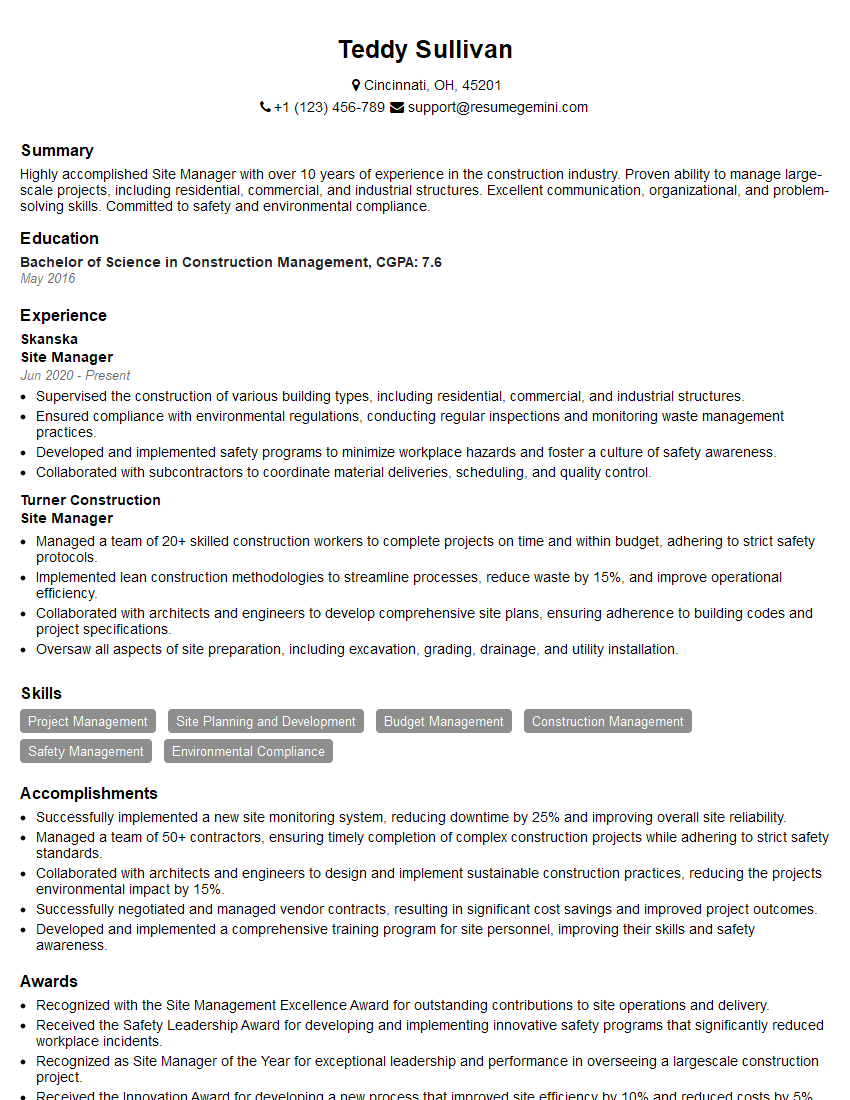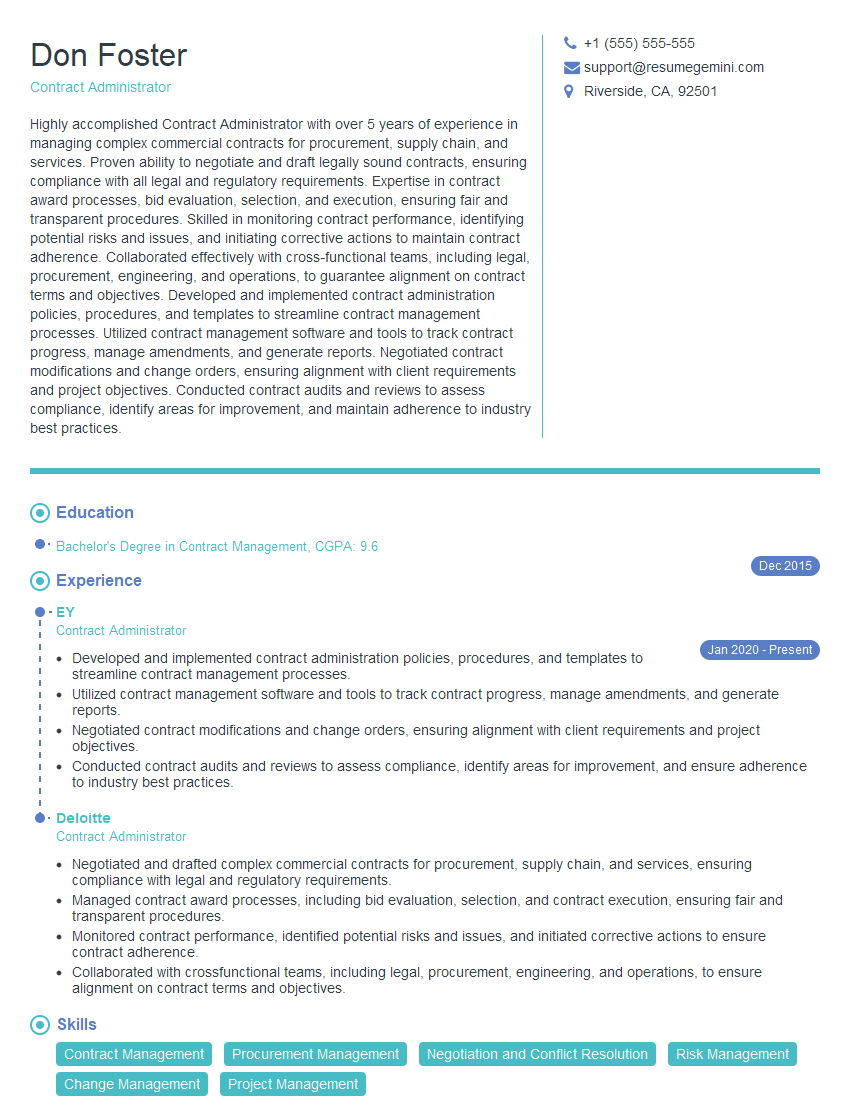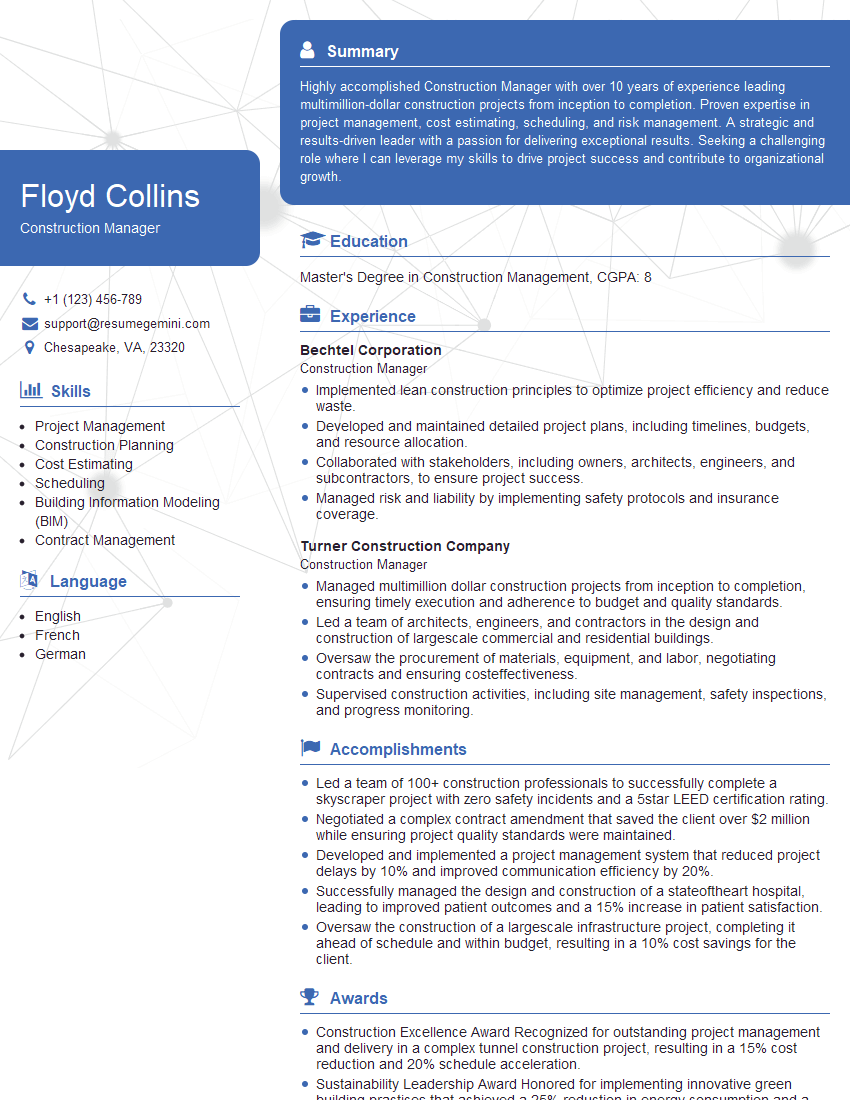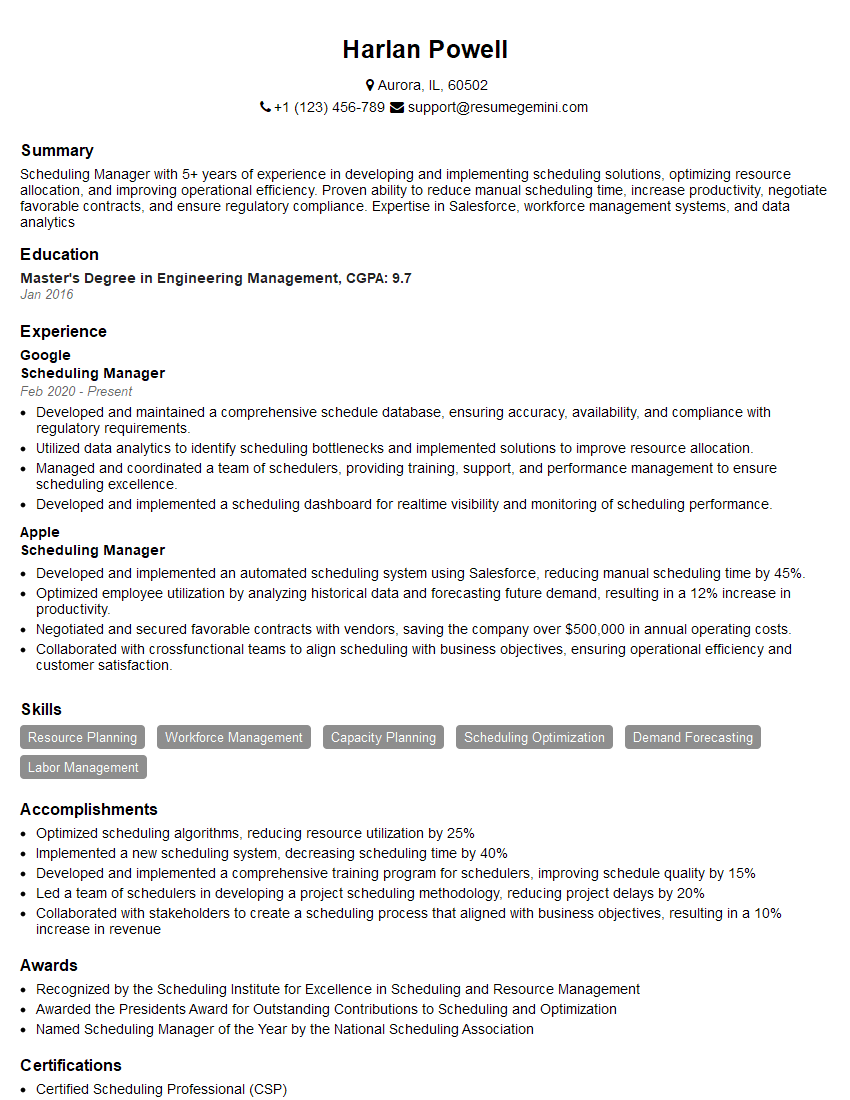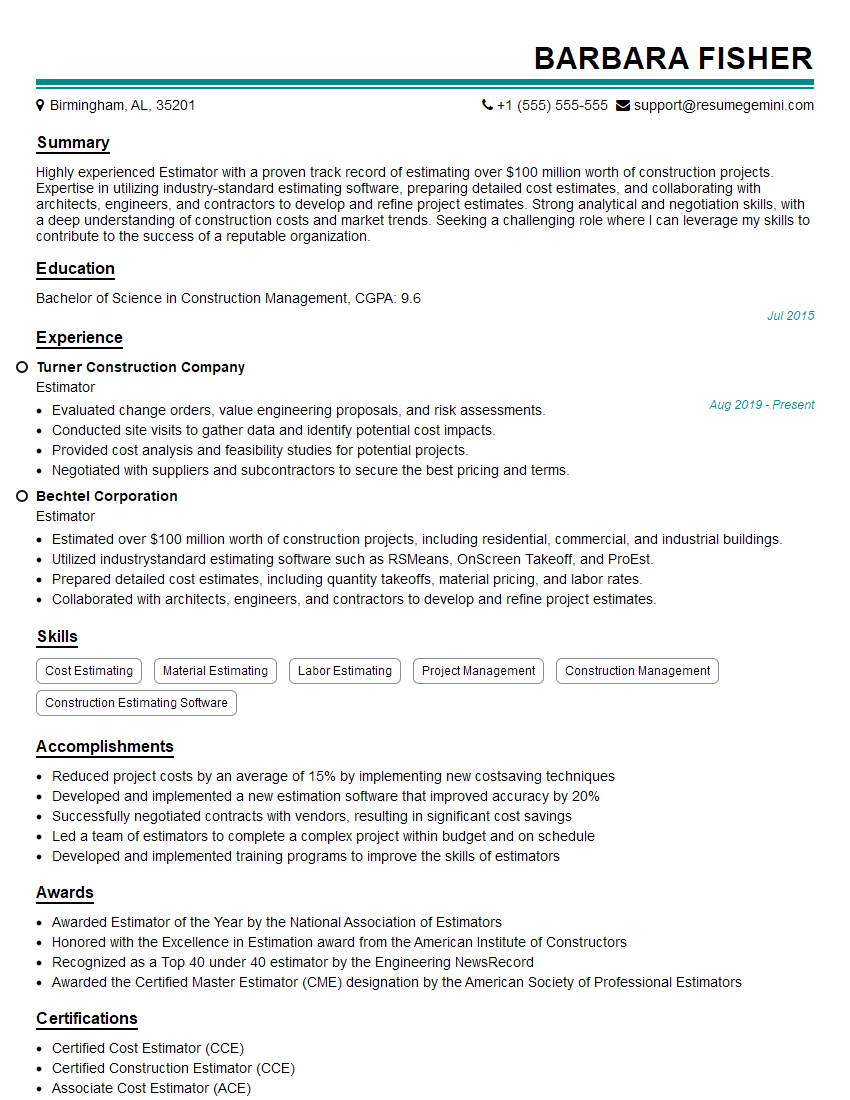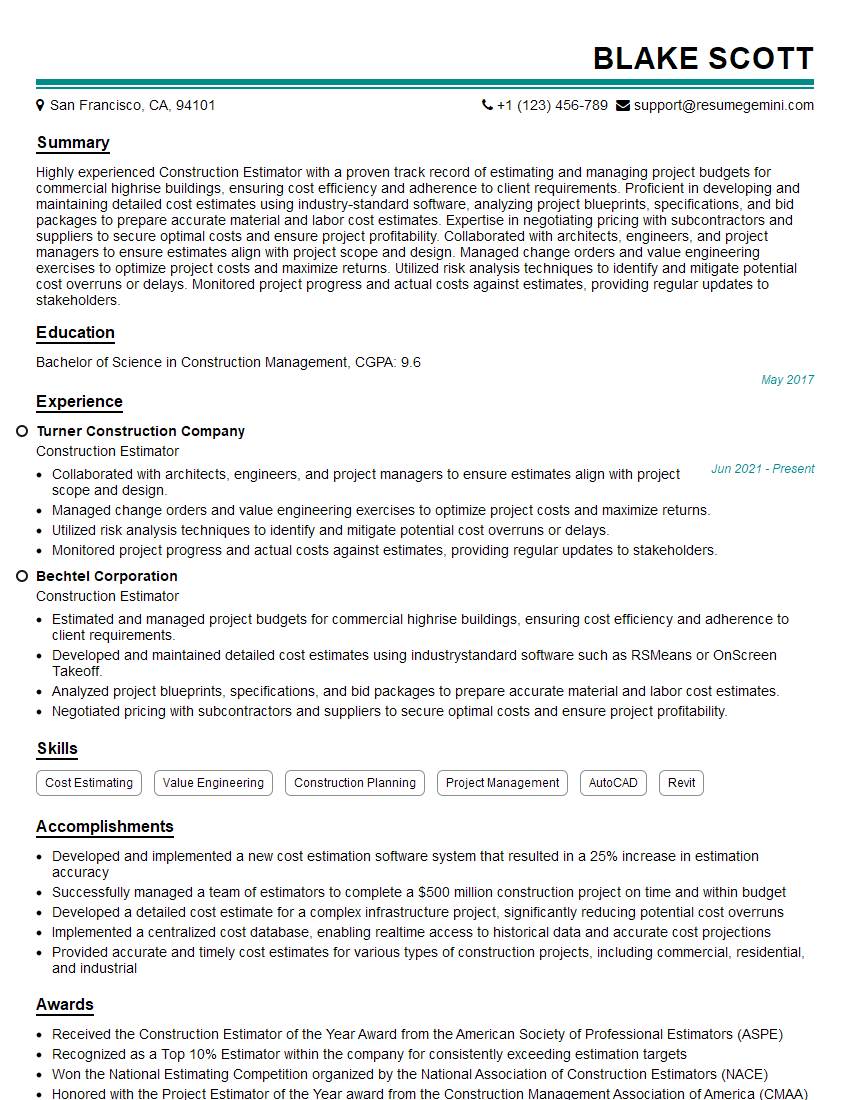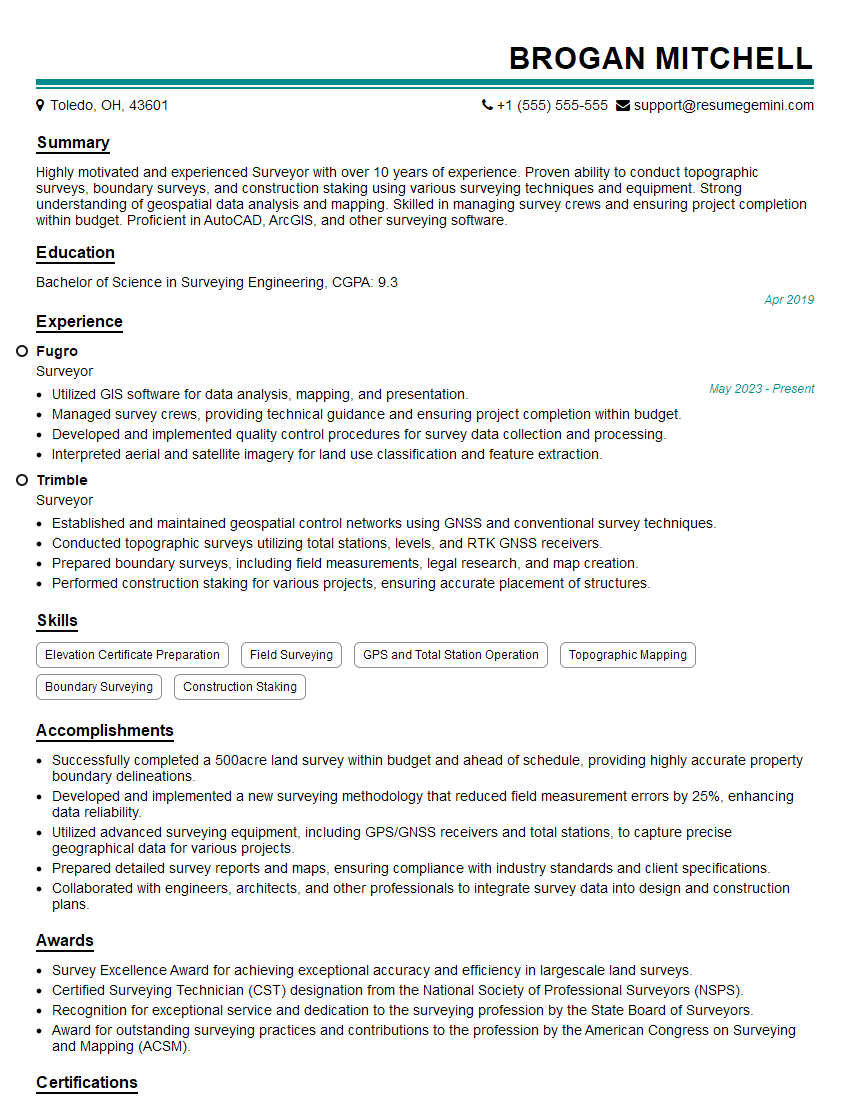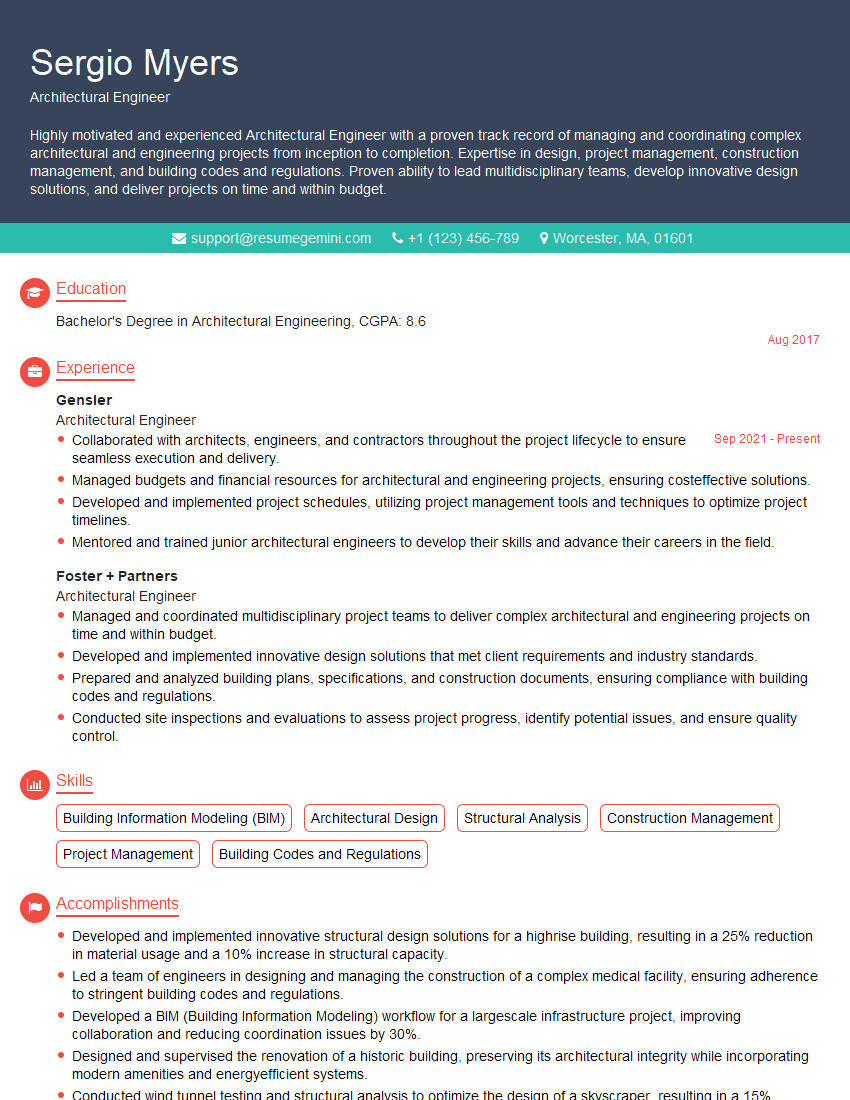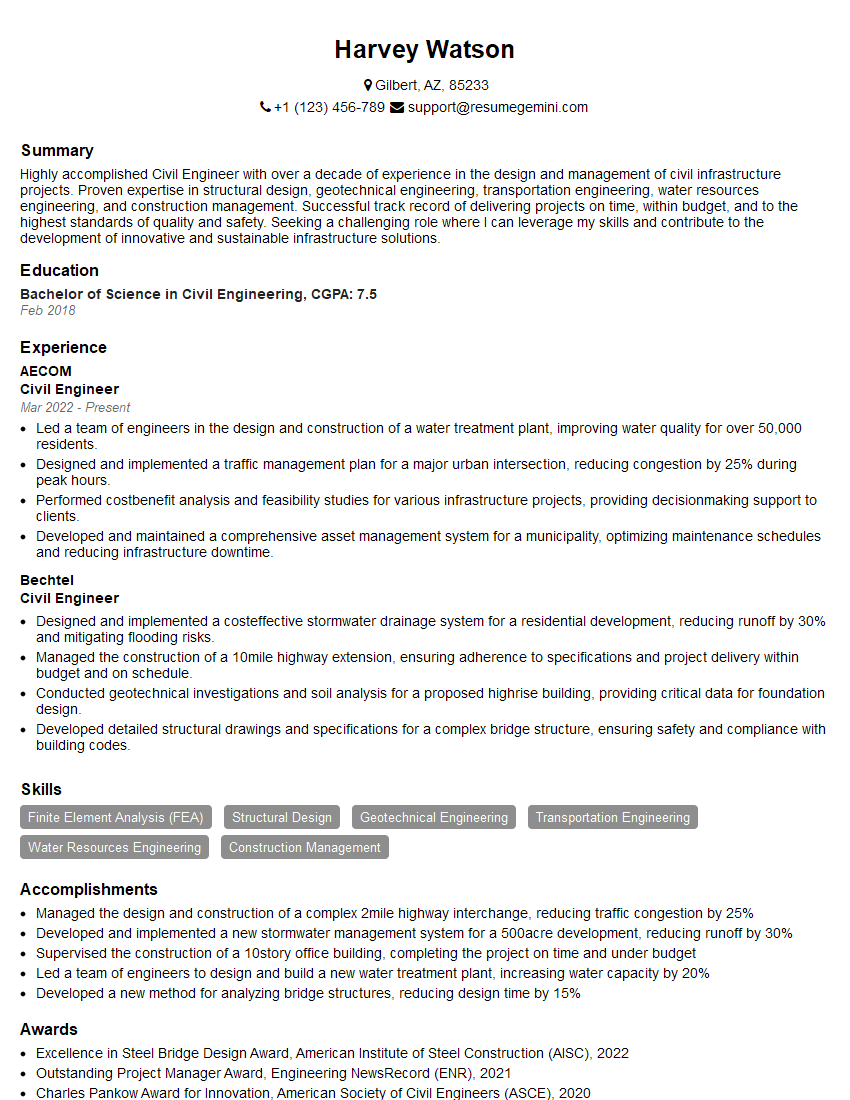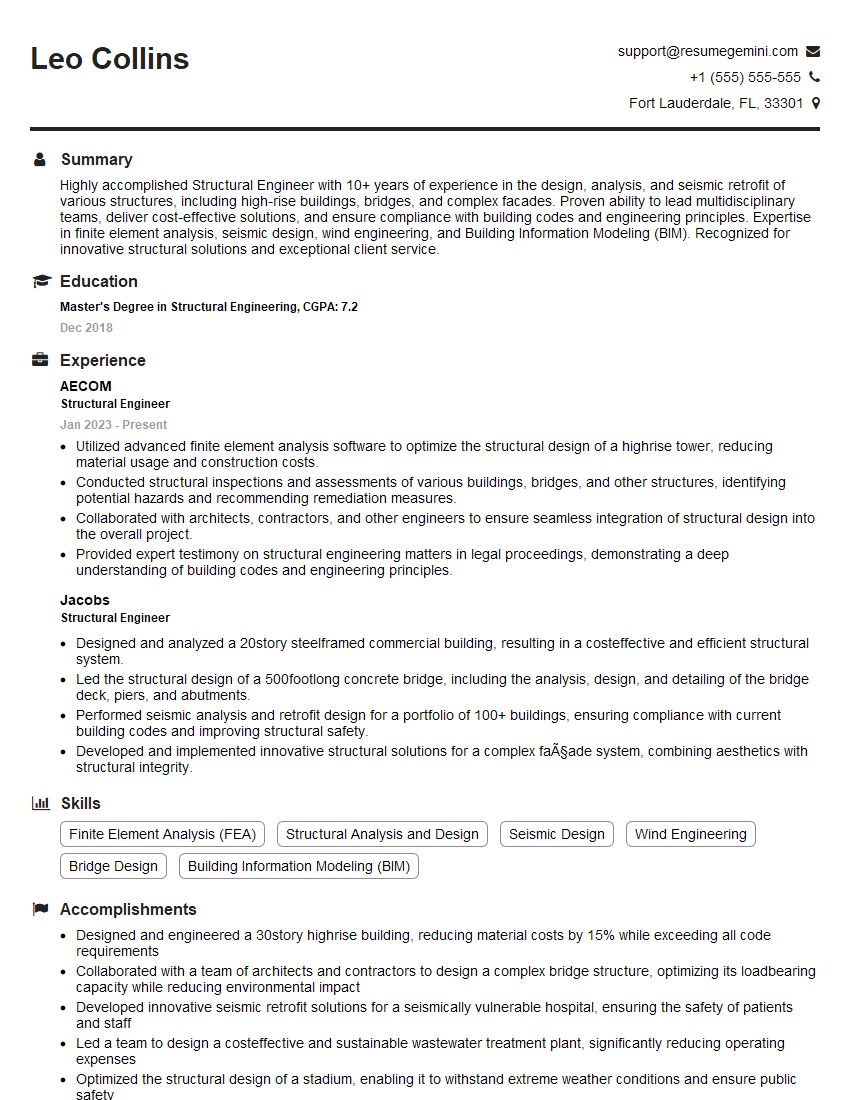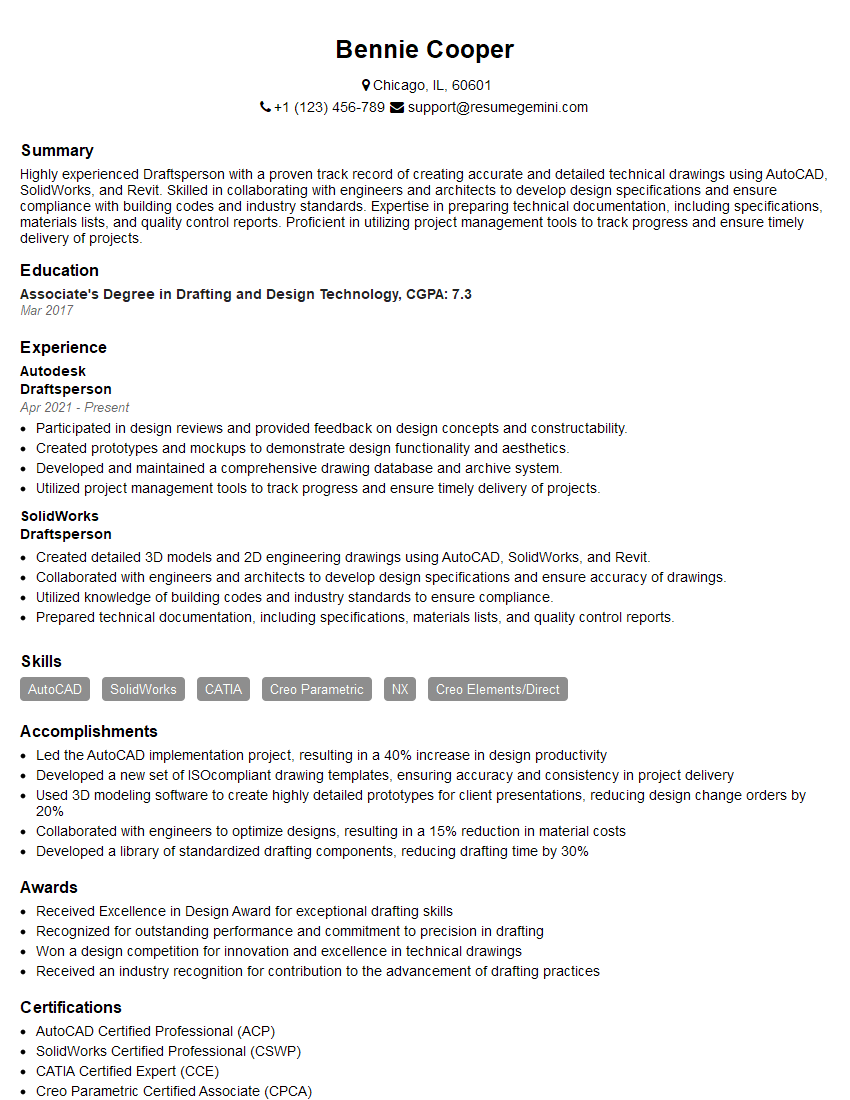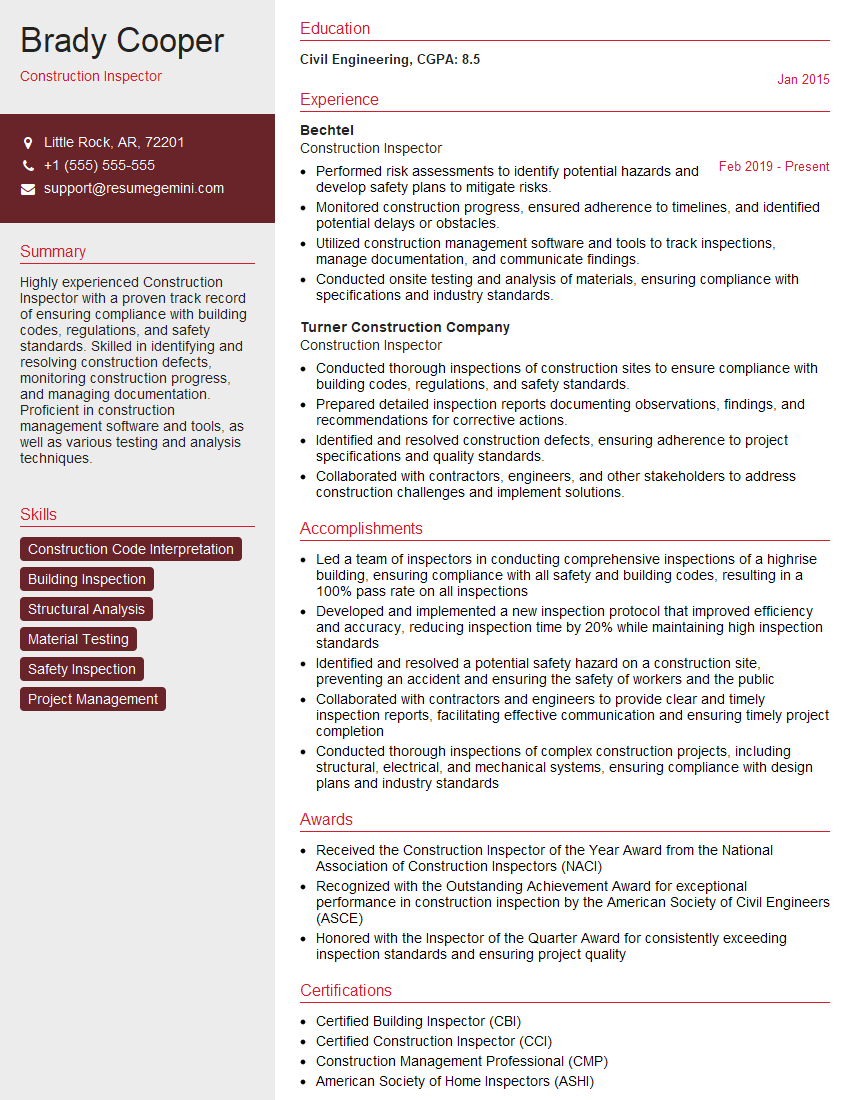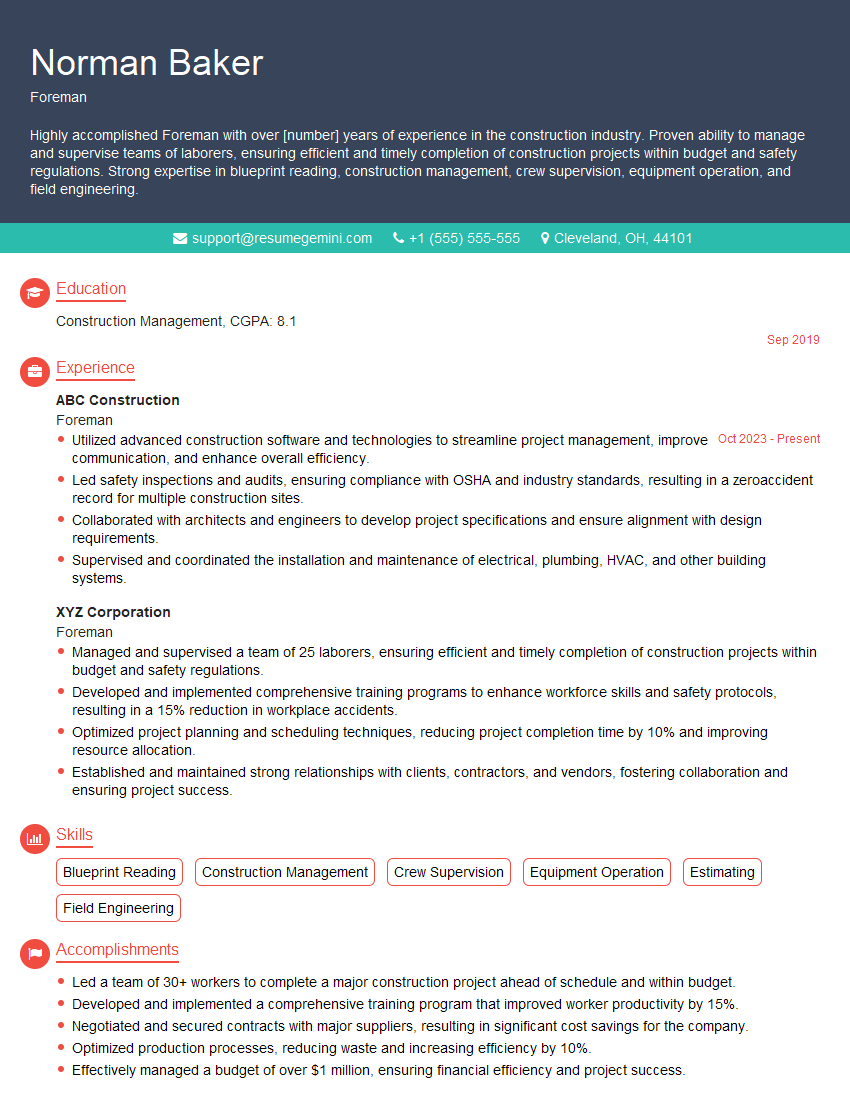Cracking a skill-specific interview, like one for Experience in construction or related field, requires understanding the nuances of the role. In this blog, we present the questions you’re most likely to encounter, along with insights into how to answer them effectively. Let’s ensure you’re ready to make a strong impression.
Questions Asked in Experience in construction or related field Interview
Q 1. Describe your experience with different construction methodologies (e.g., Agile, Lean).
My experience spans various construction methodologies, focusing on the practical application of Agile and Lean principles. Agile, known for its iterative approach, allows for flexibility and responsiveness to changing project needs. In construction, this translates to breaking down large projects into smaller, manageable sprints, allowing for frequent reviews and adjustments. For instance, on a recent school renovation, we used Agile to manage the interior finishes. Each phase (painting, flooring, fixtures) was a sprint, enabling us to adapt quickly to unforeseen issues like material delays. Lean construction, on the other hand, emphasizes eliminating waste and maximizing value. This involves streamlining processes, optimizing workflows, and minimizing unnecessary steps. On a large commercial building project, we implemented Lean principles by employing a Last Planner® System. This involved collaborative weekly planning sessions with all subcontractors, ensuring everyone was aligned and reducing rework.
The key difference is Agile focuses on iterative development and responsiveness, while Lean focuses on efficiency and waste reduction. Often, a hybrid approach – integrating elements of both – proves most effective.
Q 2. Explain your process for managing project schedules and deadlines.
Managing project schedules effectively requires a multi-pronged approach. It starts with creating a detailed and realistic schedule using project management software like Primavera P6 or MS Project. This involves clearly defining tasks, sequencing them logically, and assigning resources and durations. Crucially, this schedule needs to be regularly updated to reflect actual progress and any unforeseen challenges. This involves holding regular progress meetings with the project team, subcontractors, and clients. We track key performance indicators (KPIs) like task completion rates and identify potential delays early on.
In addition to software, effective communication is key. Transparent reporting ensures that everyone is informed about potential schedule impacts, allowing for proactive mitigation. If delays are unavoidable, we promptly communicate them to all stakeholders and develop contingency plans to minimize disruptions. I believe in leading by example and holding myself accountable to maintain deadlines.
Q 3. How do you handle conflicts between subcontractors?
Conflict resolution between subcontractors requires a fair, firm, and timely approach. My strategy involves fostering a collaborative environment from the outset, clearly defining roles and responsibilities in contracts and emphasizing open communication. When conflicts arise, my first step is to bring all parties together for a mediated discussion. The goal is to understand each perspective and identify the root cause of the disagreement. I facilitate a collaborative problem-solving process, focusing on finding mutually acceptable solutions.
Sometimes, formal dispute resolution mechanisms, as outlined in the contracts, may be necessary. This could involve arbitration or litigation as a last resort. However, I always prioritize finding amicable solutions early on to avoid project delays and cost overruns. Maintaining a positive working relationship with all subcontractors is critical for successful project completion.
Q 4. What safety procedures do you enforce on your job sites?
Safety is my paramount concern. We enforce a rigorous safety program on all job sites, beginning with comprehensive safety orientations for all personnel, including subcontractors. This orientation covers site-specific hazards, emergency procedures, and the proper use of personal protective equipment (PPE). Daily toolbox talks are conducted to address specific safety issues and reinforce best practices. Regular safety inspections are carried out, and any identified hazards are immediately addressed. We maintain detailed safety records and incident reports, ensuring prompt investigation and corrective actions.
Beyond the basics, we implement proactive measures like using safety nets, scaffolding inspections, and fall protection systems. We also encourage a culture of safety where everyone feels empowered to report hazards and concerns without fear of reprisal. Our commitment to safety is not just a policy; it’s a deeply ingrained value that shapes our everyday actions.
Q 5. Describe your experience with cost estimation and budgeting.
Accurate cost estimation and budgeting are essential for project success. My process begins with a thorough review of project plans and specifications, followed by a detailed breakdown of all required materials, labor, equipment, and other costs. I utilize various estimation techniques, including parametric estimating, unit pricing, and bottom-up estimating, depending on the project’s complexity and available data. Software like Excel and specialized estimating software are employed to create detailed cost breakdowns and budgets.
Regular cost monitoring and control are vital. We track actual costs against the budget, identifying and addressing any variances promptly. This may involve value engineering to find cost-saving measures without compromising quality. Contingency funds are incorporated into the budget to account for unforeseen circumstances and potential risks. Transparency in cost reporting to clients ensures mutual understanding and accountability throughout the project lifecycle.
Q 6. How do you manage risks and uncertainties in construction projects?
Managing risks and uncertainties requires a proactive and systematic approach. We begin by identifying potential risks through thorough risk assessments, involving all project stakeholders. This involves brainstorming sessions and utilizing checklists and historical data from previous projects. Once risks are identified, we analyze their likelihood and potential impact. This allows us to prioritize risks and develop appropriate mitigation strategies.
These strategies can range from implementing preventative measures (e.g., robust quality control procedures) to developing contingency plans (e.g., alternative sourcing of materials). We regularly monitor identified risks throughout the project lifecycle, making adjustments to mitigation strategies as needed. Regular communication keeps the team informed and fosters a culture of proactive risk management.
Q 7. What software programs are you proficient in (e.g., MS Project, Primavera P6)?
I am proficient in several software programs commonly used in construction project management. My expertise includes MS Project, Primavera P6, and Autodesk Revit. MS Project is my go-to for scheduling and resource allocation on smaller to medium-sized projects, while Primavera P6 is ideal for managing complex projects with multiple teams and intricate dependencies. Autodesk Revit is instrumental for Building Information Modeling (BIM), facilitating collaborative design and construction.
Beyond these, I am also familiar with various other software applications, including spreadsheets (Excel), cost estimation software, and project collaboration platforms. My proficiency in these tools allows for effective project management and communication, resulting in efficient and successful project delivery.
Q 8. How do you ensure quality control throughout a construction project?
Ensuring quality control in construction is a multifaceted process that begins even before the first shovel hits the ground. It’s about proactively preventing defects rather than reactively fixing them. My approach is built on a three-pronged strategy: planning, implementation, and verification.
- Planning: This involves meticulously reviewing blueprints, specifying materials and tolerances, and creating a comprehensive quality control plan that outlines inspection procedures at each stage. For example, before pouring concrete, we’d verify the formwork’s accuracy and the strength of the concrete mix according to specified standards.
- Implementation: This stage is about daily monitoring and adherence to the quality control plan. We use checklists, regular inspections, and documented sign-offs to track progress and address any issues immediately. A daily log is kept, highlighting any deviations from the plan, corrective actions taken, and the responsible party.
- Verification: This involves rigorous testing and inspections at key milestones. This might include soil testing, concrete strength tests, and inspections by third-party agencies to ensure the project meets all building codes and regulations. Regular quality meetings, involving all stakeholders, are also crucial for reviewing progress and addressing any emerging issues.
For example, on a recent high-rise project, our meticulous pre-pour inspection of the concrete formwork prevented a potential catastrophic failure by identifying and rectifying a misalignment before the concrete was poured. This prevented significant delays and cost overruns.
Q 9. Explain your experience with procurement and subcontractor management.
Procurement and subcontractor management are critical for project success. My approach focuses on meticulous planning, transparent communication, and robust performance monitoring.
- Pre-qualification: I thoroughly vet potential subcontractors based on their experience, qualifications, insurance coverage, safety records, and financial stability. This often involves requesting references and examining past project performance.
- Contract Negotiation: I ensure contracts clearly define scope of work, payment terms, timelines, and performance standards. I also incorporate clauses addressing potential disputes and change orders.
- Performance Monitoring: Regular site visits, progress reports, and performance evaluations are vital. We use a performance scoring system, allowing for objective assessment and timely identification of potential problems. Any performance issues are addressed promptly through direct communication and collaborative problem-solving.
- Payment Processing: I ensure timely and accurate payments based on completed work and adherence to contract terms. This builds trust and positive relationships with subcontractors.
On a recent project, proactive subcontractor management allowed us to avoid a critical delay by anticipating a potential shortage of skilled labor and securing additional resources early on.
Q 10. Describe your experience with change orders and contract administration.
Change orders and contract administration are integral parts of any construction project. My experience involves a clear, documented process to manage these aspects effectively.
- Change Order Process: Any requested changes are formally documented through a change order request, clearly outlining the scope of work, impact on timeline, and cost implications. This document is reviewed, approved, and signed by all relevant stakeholders.
- Contract Compliance: I carefully monitor contract compliance throughout the project, ensuring that all parties adhere to the agreed-upon terms and conditions.
- Dispute Resolution: In case of disagreements, I strive for collaborative conflict resolution, exploring different options before resorting to formal dispute resolution processes.
- Documentation: Meticulous record-keeping is paramount. All change orders, correspondence, and agreements are meticulously documented and stored in a central, easily accessible system.
In one instance, a change order request led to the discovery of a potential design flaw, resulting in significant cost savings by implementing a more efficient solution earlier in the project.
Q 11. How do you communicate effectively with clients, stakeholders, and team members?
Effective communication is the cornerstone of any successful construction project. I use a multi-pronged approach involving regular meetings, clear documentation, and active listening.
- Regular Meetings: I schedule regular meetings with clients, stakeholders, and team members, tailoring the frequency and format to suit the project’s needs and the audience. This might range from daily site huddles to weekly progress meetings with the client.
- Clear Documentation: All communication, including emails, meeting minutes, and reports, is clearly documented and distributed to relevant parties. This minimizes misunderstandings and keeps everyone informed.
- Active Listening: I prioritize active listening, ensuring I understand the perspectives of all stakeholders. This involves asking clarifying questions and providing prompt feedback.
- Technology: I leverage communication technology like project management software to facilitate communication, task assignments, and document sharing.
For example, proactive communication prevented a potential conflict by addressing a client’s concern about material selection early in the project, avoiding major setbacks later.
Q 12. How do you handle project delays and cost overruns?
Project delays and cost overruns are inevitable challenges in construction. My approach involves proactive risk management, diligent monitoring, and decisive action.
- Risk Assessment: I conduct a thorough risk assessment at the beginning of each project, identifying potential causes of delays and cost overruns. This might include weather delays, material shortages, or unforeseen site conditions.
- Contingency Planning: Based on the risk assessment, we develop contingency plans to mitigate the impact of potential problems. For example, we might have a backup plan for material procurement to avoid delays.
- Problem Solving: When delays or cost overruns occur, I engage in a collaborative problem-solving process, exploring options with the project team and stakeholders to find the most efficient solutions. This might involve adjusting the schedule, negotiating with subcontractors, or securing additional funding.
- Documentation: All delays, their causes, and the actions taken to address them are meticulously documented. This helps in future projects.
Once, during a project impacted by unexpected subsurface conditions, we implemented a revised plan to address the issue, minimizing the cost impact and avoiding a major disruption to the project timeline.
Q 13. What is your experience with building information modeling (BIM)?
Building Information Modeling (BIM) is a crucial tool for modern construction. My experience involves utilizing BIM throughout the project lifecycle, from design and planning to construction and operation.
- Design Coordination: BIM facilitates better coordination between different design disciplines, reducing clashes and conflicts during construction.
- 4D & 5D BIM: I have experience using 4D (time) and 5D (cost) BIM to simulate project progress and manage costs effectively. This allows for proactive identification of potential schedule or cost issues.
- Clash Detection: BIM’s clash detection capabilities help prevent construction errors and rework, saving time and money.
- Collaboration: BIM enhances collaboration among team members, allowing for efficient communication and information sharing.
On a recent project, the use of BIM led to a significant reduction in construction errors and rework, saving the project both time and money.
Q 14. How do you maintain accurate records and documentation?
Maintaining accurate records and documentation is paramount for successful project completion and avoiding disputes. My approach involves a combination of digital and physical record-keeping.
- Digital Records: We utilize cloud-based project management software to store all relevant documents, including contracts, drawings, change orders, inspection reports, and progress photos. This ensures accessibility, version control, and security.
- Physical Records: Important documents, like original contracts and signed change orders, are also kept in secure physical files.
- Organized Filing System: We maintain a clear and consistent filing system both digitally and physically. This ensures quick retrieval of information when needed.
- Regular Backups: Regular data backups are crucial for protecting against data loss.
This system allowed us to quickly retrieve crucial documents during a legal dispute, providing concrete evidence that supported our case and helped avoid significant financial losses.
Q 15. Explain your experience with different types of construction contracts.
Throughout my career, I’ve worked extensively with various construction contracts, each with its own nuances and risk profiles. The most common types I’ve encountered include Lump Sum, Cost Plus, and Unit Price contracts.
Lump Sum: This is a fixed-price contract where the contractor agrees to complete the project for a predetermined price. The risk is largely on the contractor, as they need to accurately estimate costs upfront. An example is a contract to build a single-family home for a set price. The client knows the total cost beforehand.
Cost Plus: In this type, the client reimburses the contractor for all allowable costs, plus a predetermined fee (percentage or fixed amount). This shifts more risk to the client, as the final cost isn’t fixed. This is often used for complex projects with evolving scopes, such as large-scale renovations or specialized industrial construction where unforeseen complexities are more likely.
Unit Price: This contract specifies a price per unit of work (e.g., $X per cubic yard of concrete, $Y per square foot of drywall). The total cost is calculated based on the actual quantities used. This is ideal for projects where the exact quantities of materials are uncertain, such as road construction or large earthworks projects. The risk is shared, as the contractor’s profit depends on efficiency and accurate quantity estimations.
My experience encompasses negotiating contract terms, managing change orders within different contract structures, and resolving disputes arising from contract ambiguities. Understanding the intricacies of each type is critical for successful project delivery and managing expectations with clients.
Career Expert Tips:
- Ace those interviews! Prepare effectively by reviewing the Top 50 Most Common Interview Questions on ResumeGemini.
- Navigate your job search with confidence! Explore a wide range of Career Tips on ResumeGemini. Learn about common challenges and recommendations to overcome them.
- Craft the perfect resume! Master the Art of Resume Writing with ResumeGemini’s guide. Showcase your unique qualifications and achievements effectively.
- Don’t miss out on holiday savings! Build your dream resume with ResumeGemini’s ATS optimized templates.
Q 16. Describe your approach to problem-solving in a construction environment.
My approach to problem-solving in construction is systematic and collaborative. I use a five-step process:
Identify the Problem: Clearly define the issue, gathering data from all relevant stakeholders. This might involve reviewing plans, talking to the team, or inspecting the site.
Analyze the Root Cause: Don’t just address symptoms; delve into the underlying reasons for the problem. This might involve using root cause analysis techniques like the ‘5 Whys’ to uncover the core issue.
Develop Solutions: Brainstorm multiple potential solutions, evaluating the feasibility, cost, and potential risks of each.
Implement the Chosen Solution: Execute the selected solution, ensuring proper communication and collaboration with the team. This often involves delegating tasks, monitoring progress, and making adjustments as needed.
Evaluate and Document: After implementation, assess the effectiveness of the solution, documenting the process and outcomes for future reference. This step is vital for continuous improvement and learning from both successes and failures.
For example, if we encounter unexpected soil conditions during excavation, I wouldn’t just order more excavation. I’d analyze the soil type, consult a geotechnical engineer, revise the foundation design if necessary, and then implement a revised plan with updated cost and schedule estimations, keeping all stakeholders informed.
Q 17. How do you motivate and manage a construction team?
Motivating and managing a construction team requires a blend of leadership styles and strategies. I believe in fostering a positive and collaborative environment, based on clear communication, respect, and recognition.
Clear Communication: Regular team meetings, transparent updates, and open dialogues are crucial. Keeping everyone informed about project progress, challenges, and expectations prevents misunderstandings.
Empowerment and Delegation: I empower team members by delegating tasks based on their skills and experience, providing support and guidance as needed. This boosts morale and develops individual capabilities.
Recognition and Reward: Acknowledging good work, celebrating milestones, and offering constructive feedback motivates the team. This can be through formal rewards or simply through verbal appreciation.
Conflict Resolution: Addressing conflicts promptly and fairly is crucial. I facilitate open dialogue, encourage compromise, and focus on finding mutually agreeable solutions.
Training and Development: Investing in the professional development of team members, through training programs or mentorship opportunities, shows commitment and fosters loyalty.
For instance, on a recent project, we celebrated the completion of a challenging phase with a team lunch. This simple act boosted morale and reinforced team unity.
Q 18. What is your experience with sustainability and green building practices?
Sustainability and green building practices are integral to my approach to construction. I’ve been involved in projects that incorporate various sustainable strategies, including:
LEED Certification: I have experience working towards LEED (Leadership in Energy and Environmental Design) certification, implementing strategies such as energy-efficient designs, water conservation techniques, and the use of sustainable materials.
Energy-Efficient Designs: This includes implementing passive solar design, high-performance windows and insulation, and energy-efficient HVAC systems.
Water Conservation: Utilizing water-efficient fixtures and landscaping, and implementing greywater recycling systems where appropriate.
Sustainable Materials: Specifying and utilizing recycled content materials, locally sourced materials to minimize transportation emissions, and materials with low embodied carbon.
Waste Management: Implementing comprehensive waste management plans that prioritize recycling and minimizing waste sent to landfills.
In one project, we used recycled steel for the structural framework, reducing the project’s carbon footprint significantly. The resulting cost savings from reduced energy consumption were also a significant benefit for the client.
Q 19. Describe your experience with different types of construction materials.
My experience encompasses a wide range of construction materials, from traditional to cutting-edge. I’m familiar with the properties, applications, and limitations of various materials, including:
Structural Materials: Steel, reinforced concrete, timber, masonry.
Exterior Finishes: Brick, stone, stucco, siding, roofing materials (asphalt shingles, metal, tile).
Interior Finishes: Drywall, plaster, flooring materials (tile, wood, carpet), paint.
Insulation Materials: Fiberglass, cellulose, spray foam.
Specialized Materials: High-performance concrete, composite materials, sustainable and recycled materials.
Understanding material properties is crucial for making informed decisions about material selection, ensuring structural integrity, and optimizing project costs. For example, choosing the right type of concrete mix is critical for ensuring the durability and longevity of a foundation, dependent on the soil conditions and anticipated loads.
Q 20. How do you ensure compliance with building codes and regulations?
Ensuring compliance with building codes and regulations is paramount. My approach is proactive and involves:
Thorough Plan Review: Before construction begins, we meticulously review all plans and specifications to ensure they meet all applicable codes and regulations. This often involves collaborating with engineers and architects to address any potential compliance issues upfront.
Regular Inspections: We conduct regular on-site inspections throughout the construction process to verify that the work complies with the approved plans and codes. This includes engaging with building inspectors at various stages of the project.
Maintaining Accurate Records: We maintain meticulous records of all inspections, permits, and any modifications made during construction. This documentation is crucial for demonstrating compliance in case of audits or disputes.
Staying Updated on Codes: The building codes are constantly evolving. Staying abreast of the latest changes is crucial. We use subscription services and attend industry events to remain up-to-date.
Collaboration with Authorities: Open communication with building inspectors and other relevant authorities is essential to proactively address any concerns and ensure smooth project approval.
Ignoring code compliance can lead to costly delays, fines, and even legal action. A proactive approach minimizes these risks and ensures the safety and quality of the finished project.
Q 21. What are your strengths and weaknesses as a construction professional?
My strengths as a construction professional include my strong problem-solving skills, my ability to manage and motivate teams effectively, and my commitment to delivering projects on time and within budget. I’m adept at handling complex projects, managing multiple stakeholders, and proactively addressing challenges.
However, I also recognize my weaknesses. I sometimes tend to be too detail-oriented, which can occasionally slow down the decision-making process. I’m actively working to improve my ability to delegate more effectively and trust my team’s judgment on tasks where appropriate. I also seek to develop my skills in advanced project management software and techniques to further optimize project efficiency and scheduling.
Q 22. Describe a time you had to make a difficult decision on a construction project.
One of the toughest decisions I faced involved a significant schedule delay on a high-rise project. We experienced unforeseen issues with the foundation due to unexpected soil conditions. The original plan was to complete the foundation within six weeks. However, the discovery of unstable bedrock forced a complete redesign, adding at least three more weeks to the timeline. This delay threatened to impact the entire project, triggering potential penalties with the client and impacting the sub-contractor schedules.
The difficult decision was whether to proceed with the redesign immediately, incurring additional costs and potentially causing further delays, or to attempt to work around the problem, risking structural integrity and potentially incurring even greater costs later.
After careful analysis involving geotechnical engineers, the project manager, and the client, we opted for the redesign. This involved transparent communication with the client, explaining the necessity of the changes and outlining the revised timeline and associated costs. Though expensive and time-consuming in the short-term, the proactive approach minimized the long-term risks, maintained client confidence, and ultimately prevented a much larger disaster.
Q 23. How do you handle stressful situations on a construction site?
Stressful situations on a construction site are inevitable. My approach focuses on proactive planning and effective communication. First, I identify the source of the stress. Is it a deadline issue, a material shortage, a conflict between team members, or a technical challenge?
Once identified, I implement a structured approach:
- Problem Definition: Clearly define the problem and its impact.
- Collaboration: I involve the relevant team members to brainstorm solutions. Open communication and collaboration are critical.
- Prioritization: We prioritize tasks based on urgency and impact. We focus on addressing the most critical issues first.
- Risk Mitigation: We identify potential risks associated with each solution and develop contingency plans.
- Solution Implementation: We implement the chosen solution and monitor its effectiveness. Regular updates are essential.
- Post-Incident Review: Following the resolution, we conduct a post-incident review to identify areas for improvement in our processes to avoid similar situations in the future.
Beyond this, I prioritize self-care. Maintaining a healthy work-life balance through proper rest and exercise helps me manage stress more effectively.
Q 24. What are your salary expectations?
My salary expectations are in line with the industry standard for a position with my experience and skill set. Considering my background in [mention specific area of expertise, e.g., high-rise construction, project management], and my proven track record of success, I am targeting a salary range of $[Lower Bound] to $[Upper Bound]. However, I am open to discussing this further based on the specifics of the role and the overall compensation package.
Q 25. Why are you interested in this specific construction job?
I’m highly interested in this specific construction job because of [Company Name]’s reputation for [mention company’s positive attributes, e.g., innovative projects, commitment to safety, employee development]. The opportunity to work on the [Project Name] project, specifically, is particularly appealing due to [mention specific aspects that interest you, e.g., its scale, its use of cutting-edge technology, its sustainable design]. I believe my skills and experience in [mention relevant skills, e.g., project management, cost control, scheduling] align perfectly with the requirements outlined in the job description, and I am confident I can make significant contributions to your team.
Q 26. What are your long-term career goals in construction?
My long-term career goals involve progressing into a senior leadership role within the construction industry. I aspire to leverage my expertise to manage and oversee larger, more complex projects, while mentoring and developing the next generation of construction professionals. Specifically, I am interested in pursuing [mention specific career paths, e.g., Project Management Professional (PMP) certification, a leadership role in sustainable construction, or specializing in a niche area like BIM management]. Continuous learning and professional development are crucial to achieving these goals.
Q 27. Describe a time you had to solve a complex technical problem.
During the construction of a large-scale commercial building, we encountered a significant challenge with the installation of a complex HVAC system. The system’s design included intricate ductwork that was proving difficult to install within the confines of the existing structure.
The problem was two-fold: firstly, the physical constraints of the space made it impossible to install the ductwork using traditional methods. Secondly, the tight schedule meant that any delay could have serious financial repercussions.
To solve this, I initiated a series of steps:
- 3D Modeling Review: We carefully re-examined the 3D model of the HVAC system and the building structure to identify potential conflicts and areas for improvement.
- Expert Consultation: We consulted with the HVAC system manufacturer and an experienced ductwork installation specialist.
- Alternative Installation Methods: We explored alternative methods, including prefabricating sections of the ductwork off-site and using specialized robotic tools to maneuver the ductwork into tight spaces.
- Revised Schedule: We revised the project schedule to accommodate the additional time required for the prefabrication and specialized installation process.
By implementing these solutions, we successfully installed the HVAC system within the revised time frame and without compromising the quality or safety of the work.
Q 28. How do you stay up-to-date with the latest construction technologies and best practices?
Staying current with the latest construction technologies and best practices is paramount in this dynamic industry. I employ a multi-pronged approach:
- Professional Organizations: I actively participate in professional organizations such as [mention relevant organizations, e.g., Associated General Contractors of America (AGC), American Society of Civil Engineers (ASCE)], attending conferences and workshops to learn about the latest innovations and best practices.
- Industry Publications and Journals: I regularly read industry publications, journals and online resources to stay informed about the latest research, technologies, and trends. Examples include Engineering News-Record (ENR) and Construction Dive.
- Online Courses and Webinars: I utilize online learning platforms to take courses and webinars focused on emerging technologies, such as BIM, digital twins, and sustainable building practices.
- Networking: I actively network with other construction professionals through industry events, online forums and communities to learn from their experiences and share knowledge.
- On-the-Job Learning: I proactively seek opportunities to learn new skills and technologies on my current projects.
This continuous learning process ensures that I am always equipped with the most up-to-date knowledge and skills, enabling me to contribute effectively to projects and remain competitive in the industry.
Key Topics to Learn for Construction/Related Field Interviews
- Project Management Fundamentals: Understanding project timelines, budgets, and resource allocation. Practical application includes explaining your role in managing a past project’s budget or schedule.
- Safety Regulations and Practices: OSHA compliance, hazard identification, and risk mitigation. Demonstrate your understanding through examples of how you’ve ensured safety on a job site.
- Blueprint Reading and Interpretation: Understanding technical drawings, specifications, and construction documents. Be prepared to discuss your experience interpreting blueprints to complete tasks.
- Construction Materials and Methods: Knowledge of various materials (concrete, steel, wood) and construction techniques. Highlight your experience with different materials and methods used in your projects.
- Problem-Solving and Troubleshooting: Addressing unexpected challenges and finding efficient solutions on the job site. Prepare specific examples of problems you encountered and how you overcame them.
- Teamwork and Communication: Effective collaboration with diverse teams including engineers, contractors, and laborers. Showcase your communication skills and ability to work effectively in a team.
- Quality Control and Assurance: Ensuring adherence to quality standards and identifying potential defects. Explain your role in maintaining quality control in previous projects.
- Technology in Construction: Familiarity with construction software (e.g., BIM software), surveying tools, and other technological advancements. Discuss any relevant experience with these technologies.
Next Steps
Mastering these key areas significantly boosts your chances of landing your dream construction role. A strong understanding of construction principles and practical applications demonstrates your value to potential employers and accelerates your career growth. To increase your visibility to hiring managers, creating an ATS-friendly resume is crucial. ResumeGemini is a trusted resource to help you build a professional and impactful resume that gets noticed. We provide examples of resumes tailored to the construction and related fields to help you get started.
Explore more articles
Users Rating of Our Blogs
Share Your Experience
We value your feedback! Please rate our content and share your thoughts (optional).
What Readers Say About Our Blog
good
